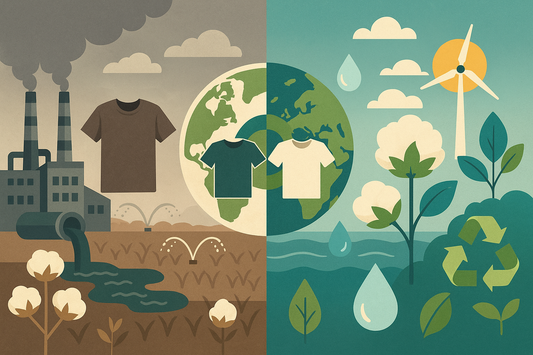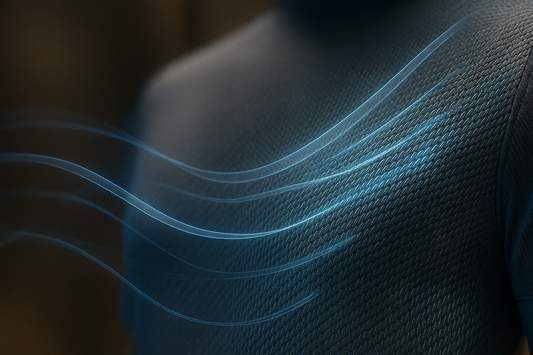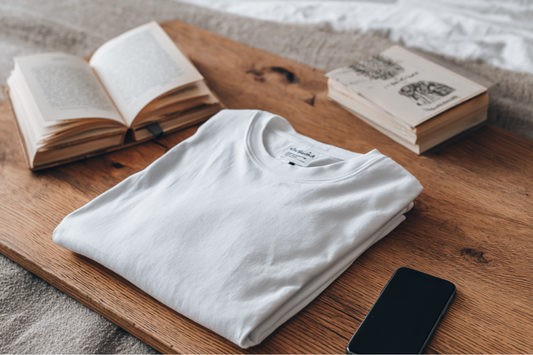
The Psychology of Colors in T-Shirt Design: How to Choose Colors That Drive Sales and Build Brand Identity
Creating a successful T-shirt brand isn't just about eye-catching graphics or premium fabric quality - it's about understanding the powerful psychological impact of colors on consumer behavior. In today's competitive D2C apparel market, the colors you choose for your T-shirt designs can make the difference between a customer scrolling past or stopping to make a purchase.
Color psychology in fashion isn't just theory - it's a proven marketing strategy that influences emotions, purchasing decisions, and brand perception. Every shade, tint, and hue communicates something specific to your audience, often on a subconscious level. But how do you harness this knowledge to create T-shirt designs that not only look great but also drive conversions?
In this comprehensive guide, we'll explore the science behind color psychology, decode what different colors communicate to consumers, and provide actionable strategies to optimize your T-shirt color choices for maximum impact.
Why Color Psychology Matters in T-Shirt Design
Before diving into specific color meanings, let's understand why color psychology is crucial for apparel brands, particularly in the competitive T-shirt market:
Instant Emotional Response: Colors trigger immediate emotional reactions—customers form opinions about your brand within 90 seconds, and 62-90% of that assessment is based on color alone.
Brand Recognition: Consistent color usage increases brand recognition by up to 80%, making your T-shirts instantly identifiable in crowded marketplaces.
Purchase Influence: Studies show that color can increase purchase intent by up to 85%, making it one of the most powerful tools in your design arsenal.
Gender and Age Targeting: Different demographics respond to colors differently, allowing you to tailor designs to specific audience segments.
Cultural Significance: Colors carry different meanings across cultures, essential for brands targeting global markets.
Whether you're designing minimalist basics or bold statement pieces, understanding color psychology gives you a competitive edge in connecting with your target audience.
The Science Behind Color Psychology
Color psychology is rooted in both evolutionary biology and cultural conditioning. Humans have developed color associations over thousands of years—red signals danger or passion, green represents nature and growth, blue conveys trust and stability.
How Colors Affect the Brain:
Neurological Response: Colors stimulate different areas of the brain, affecting mood, energy levels, and decision-making processes.
Hormonal Impact: Certain colors can trigger the release of specific hormones—red increases adrenaline, while blue promotes serotonin production.
Memory Association: Colors create strong memory connections, helping consumers remember your brand and products.
Attention and Focus: Different colors affect attention spans and focus levels, influencing how long customers engage with your designs.
Decoding Color Meanings for T-Shirt Design
Red: Power, Passion, and Urgency
Red is one of the most powerful colors in marketing, evoking strong emotional responses and creating a sense of urgency.
Psychological Impact:
- Increases heart rate and creates excitement
- Associated with passion, energy, and boldness
- Stimulates appetite and impulsive behavior
- Conveys confidence and leadership
Best Use Cases for T-Shirt Design:
- Sports and fitness apparel
- Bold statement designs
- Limited edition or sale items
- Brands targeting young, energetic demographics
Design Tips:
- Use sparingly as accent color to avoid overwhelming
- Pair with neutral colors for balance
- Consider different shades: crimson for luxury, bright red for energy
- Blue: Trust, Stability, and Professionalism
Blue: Trust, Stability, and Professionalism
Blue is the most universally liked color, making it a safe yet powerful choice for T-shirt designs.
Psychological Impact:
- Promotes feelings of trust and reliability
- Has a calming, stress-reducing effect
- Associated with intelligence and competence
- Conveys stability and dependability
Best Use Cases:
- Corporate or business casual T-shirts
- Tech company merchandise
- Healthcare or wellness brands
- Designs targeting professional audiences
Design Variations:
- Navy blue: Professional and authoritative
- Light blue: Calming and approachable
- Royal blue: Confident and premium
- Green: Nature, Growth, and Harmony
Green: Nature, Growth, and Harmony
Green represents balance, growth, and environmental consciousness—increasingly important in today's market.
Psychological Impact:
- Most restful color for human eyes
- Associated with nature, health, and sustainability
- Conveys growth, prosperity, and renewal
- Promotes feelings of balance and harmony
Perfect For:
- Eco-friendly or sustainable fashion brands
- Outdoor and adventure apparel
- Health and wellness T-shirts
- Brands emphasizing natural or organic materials
Shade Considerations:
- Forest green: Sophisticated and natural
- Lime green: Energetic and youthful
- Sage green: Calming and premium
- Yellow: Optimism, Energy, and Attention
Yellow: Optimism, Energy, and Attention
Yellow is the most attention-grabbing color, perfect for brands wanting to stand out.
Psychological Effects:
- Stimulates mental activity and energy
- Associated with happiness, optimism, and creativity
- Grabs attention quickly
- Can increase metabolism and energy levels
Ideal Applications:
- Children's apparel
- Creative and artistic brands
- Summer or beach-themed designs
- Brands targeting cheerful, optimistic audiences
Usage Warnings:
- Can be overwhelming in large quantities
- May cause eye strain if too bright
- Use strategically as accent or highlight color
Black: Sophistication, Power, and Elegance
Black is a timeless choice that never goes out of style, offering versatility and sophistication.
Psychological Associations:
- Conveys luxury, elegance, and sophistication
- Associated with power, authority, and mystery
- Creates a slimming visual effect
- Represents timelessness and classic style
Strategic Uses:
- Premium or luxury T-shirt lines
- Minimalist and contemporary designs
- Formal or evening wear
- Brands targeting sophisticated demographics
Design Benefits:
- Makes other colors pop when used as background
- Universally flattering and versatile
- Easy to match with other wardrobe pieces
White: Purity, Simplicity, and Clean Design
White represents cleanliness, simplicity, and new beginnings—a foundation color for many successful brands.
Psychological Impact:
- Associated with purity, cleanliness, and innocence
- Conveys simplicity and minimalism
- Creates sense of space and openness
- Represents new beginnings and fresh starts
Best Applications:
- Minimalist fashion brands
- Healthcare and wellness apparel
- Clean, modern design aesthetics
- Base color for colorful graphics
Purple: Luxury, Creativity, and Spirituality
Purple has historically been associated with royalty and luxury, making it perfect for premium positioning.
Psychological Effects:
- Associated with luxury, wealth, and sophistication
- Stimulates creativity and imagination
- Conveys mystery and spirituality
- Appeals to artistic and creative personalities
Effective Uses:
- Premium or luxury T-shirt collections
- Creative and artistic brand positioning
- Wellness and spiritual apparel
- Brands targeting creative professionals
Orange: Enthusiasm, Creativity, and Fun
Orange combines the energy of red with the happiness of yellow, creating an energetic and approachable color.
Psychological Properties:
- Stimulates enthusiasm and excitement
- Associated with creativity and adventure
- Conveys friendliness and approachability
- Increases oxygen supply to the brain
Strategic Applications:
- Sports and fitness brands
- Creative and artistic designs
- Youth-oriented apparel
- Adventure and outdoor brands
Cultural Considerations in Color Choice
Understanding cultural color associations is crucial for brands targeting diverse or international markets.
Western Culture Color Associations:
- Red: Love, passion, danger
- White: Purity, weddings, peace
- Black: Sophistication, mourning, power
- Blue: Trust, masculinity, calm
Eastern Culture Variations:
- Red: Good luck, prosperity, celebration
- White: Mourning, death in some cultures
- Yellow: Imperial power, wisdom
- Green: New beginnings, fertility
Global Considerations:
- Research target market cultural associations
- Test color preferences in different regions
- Consider religious and cultural sensitivities
- Adapt color strategies for international expansion
Gender and Age-Based Color Preferences
Gender Differences:
Men typically prefer:
- Bold, saturated colors
- Blue, green, and black
- Simpler color combinations
- Colors associated with strength and reliability
Women often gravitate toward:
- Softer, more complex color combinations
- Purple, pink, and blue variations
- Colors with emotional resonance
- Sophisticated color palettes
Age-Based Preferences:
Gen Z (18-25):
- Bold, vibrant colors
- Neon and electric shades
- Color combinations that stand out
- Colors that express individuality
Millennials (26-40):
- Authentic, natural colors
- Muted, sophisticated palettes
- Colors that reflect personal values
- Sustainable and eco-friendly associations
Gen X & Boomers (40+):
- Classic, timeless colors
- Professional and refined palettes
- Colors that convey quality and tradition
- Comfortable, familiar color choices
Color Combinations That Convert
High-Converting Color Combinations:
Classic Contrasts:
- Black and white: Timeless and versatile
- Navy and white: Professional and clean
- Red and white: Bold and attention-grabbing
Complementary Pairs:
- Blue and orange: Dynamic and energetic
- Purple and yellow: Creative and vibrant
- Green and red: Natural yet bold
Analogous Harmony:
- Blue, blue-green, green: Calming and natural
- Red, red-orange, orange: Energetic and warm
- Purple, blue-purple, blue: Sophisticated and cool
Triadic Schemes:
- Red, yellow, blue: Primary and bold
- Orange, green, purple: Vibrant and creative
- Pink, yellow, cyan: Playful and modern
Seasonal Color Strategy
Spring/Summer Collections:
- Bright, energetic colors
- Pastels and light shades
- Colors that evoke warmth and sunshine
- Fresh, vibrant combinations
Trending Colors:
- Coral and peach tones
- Bright blues and greens
- Sunny yellows
- Fresh whites and light grays
Fall/Winter Collections:
- Rich, deep colors
- Warm, cozy tones
- Earth-inspired palettes
- Sophisticated, muted shades
Popular Choices:
- Deep burgundy and wine
- Forest and hunter greens
- Rich browns and tans
- Classic navy and charcoal
Industry-Specific Color Psychology
Fitness and Sports Apparel:
- Red: Energy, power, motivation
- Black: Strength, intensity, performance
- Bright colors: Visibility, energy, motivation
- Blue: Reliability, trust, endurance
Luxury and Premium Brands:
- Black: Sophistication, exclusivity
- Gold/Metallic: Luxury, premium quality
- White: Clean, premium, minimalist
- Deep colors: Rich, sophisticated, expensive
Eco-Friendly and Sustainable Brands:
- Green: Nature, sustainability, growth
- Earth tones: Natural, organic, authentic
- Blue: Clean, pure, environmental
- Brown: Organic, natural, grounded
Tech and Innovation:
- Blue: Trust, innovation, technology
- Gray: Modern, sophisticated, neutral
- White: Clean, futuristic, simple
- Electric colors: Innovation, cutting-edge
Testing and Optimizing Color Choices
A/B Testing Color Strategies:
Product Photography:
- Test different background colors
- Compare color combinations in lifestyle shots
- Analyze which colors generate more clicks
Website and Marketing:
- Test button colors for conversion rates
- Compare color schemes in email marketing
- Analyze social media engagement by color
Market Research Methods:
- Survey target audience color preferences
- Conduct focus groups for color feedback
- Analyze competitor color strategies
- Monitor color trend data
Analytics to Track:
- Conversion rates by color variation
- Time spent viewing different colored designs
- Social media engagement rates
- Return rates by color choice
Common Color Psychology Mistakes
Over-Saturation: Using too many bright colors can overwhelm customers and reduce sales.
Cultural Insensitivity: Ignoring cultural color associations can alienate international customers.
Gender Stereotyping: Relying on outdated gender color assumptions limits market appeal.
Trend Chasing: Following color trends without considering brand identity confuses customers.
Ignoring Context: Not considering where and how T-shirts will be worn affects color effectiveness.
Implementation Strategy: 90-Day Color Optimization Plan
Month 1: Research and Analysis
- Analyze current color performance
- Research target audience preferences
- Study competitor color strategies
- Identify cultural considerations
Month 2: Testing and Development
- Create color variation prototypes
- Conduct A/B tests on key designs
- Gather customer feedback
- Refine color palette based on data
Month 3: Launch and Monitor
- Implement optimized color strategy
- Launch new color variations
- Monitor performance metrics
- Plan next quarter's color evolution
Real-World Success Story
At Varthagam International, we recently worked with a D2C T-shirt startup that was struggling with low conversion rates despite having great designs. Through our color psychology analysis, we discovered several critical issues:
The Challenge:
- Their primary color palette was too aggressive for their target demographic
- Cultural color associations weren't considered for their international customers
- No systematic approach to seasonal color variations
Our Solution:
- Conducted comprehensive color preference research
- Redesigned their core palette based on psychological principles
- Implemented A/B testing for all new color variations
- Created seasonal color strategies
The Results:
- 45% increase in conversion rates within 3 months
- 60% improvement in social media engagement on color-optimized posts
- 30% reduction in return rates due to better color satisfaction
- 25% increase in average order value through strategic color bundling
Our integrated approach combined color psychology research with data-driven testing, resulting in a comprehensive color strategy that delivered measurable business results.
Future Trends in Color Psychology
Emerging Color Trends:
- Digital-Inspired Colors: Cyber blues, electric greens, virtual purples
- Sustainable Hues: Natural earth tones, organic greens, recycled grays
- Mental Health Colors: Calming pastels, stress-reducing blues, mood-boosting yellows
- Gender-Neutral Palettes: Inclusive colors that appeal to all gender identities
Technology Integration:
- AI-powered color recommendation systems
- Augmented reality color visualization
- Personalized color preferences based on data
- Dynamic color adaptation based on user behavior
Final Thoughts
Color psychology in T-shirt design isn't just about making your products look good - it's about creating an emotional connection with your customers that drives purchasing decisions and builds brand loyalty. The most successful apparel brands understand that color is a powerful communication tool that speaks directly to consumers' subconscious minds.
Remember, there's no one-size-fits-all approach to color psychology. What works for one brand may not work for another, depending on target audience, brand positioning, and cultural context. The key is to understand your specific market, test different approaches, and continuously optimize based on real data and customer feedback.
Start with the psychological foundations outlined in this guide, but always validate your color choices through testing and customer feedback. The intersection of science and creativity in color selection is where truly successful T-shirt brands are built.
Your color choices today will shape your brand's identity for years to come—make them count.
Ready to Transform Your T-Shirt Designs with Color Psychology?
At Varthagam International, we specialize in helping apparel brands leverage color psychology to increase sales and build stronger brand identities. Our comprehensive approach combines scientific research with creative expertise to develop color strategies that convert.
Visit Varthagam international.in or Book a Call with us or Chat with us on Whatsapp to schedule a consultation and discover how color psychology can transform your T-shirt brand's performance.
Ready to harness the power of color psychology? Let's create T-shirt designs that not only look amazing but also drive sales through strategic color choices.



